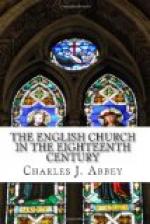He was no less active with his pen in efforts aimed at infusing an earnest spirit of practical piety, and bringing home to men’s thoughts an appreciative feeling of the value of Church ordinances. He published his ‘Practice of True Devotion’ in 1698, an excellent work, which attracted little attention when it first came out, but reached at least its twenty-second edition before the next century was completed. His treatise on the ‘Christian Sacrifice’ appeared in 1706, his ’Life of Bishop Bull’ in 1713; but it is by his ‘Festivals and Fasts’ that his name has been made familiar to every succeeding generation of Churchmen. Its catechetical form, and the somewhat formal composure of its style, did not strike past readers as defects. It certainly was in high favour among English Churchmen generally. Dr. Johnson said of it in 1776 that he understood it to have the greatest sale of any book ever printed in England except the Bible.[6] In the first four years and a half after its issue from the press more than 10,000 copies were printed.[7]
Robert Nelson died in the January of 1715, a man so universally esteemed that it would be probably impossible to find his name connected in any writer with a single word of disparagement. It would be folly to speak of one thus distinguished by singular personal qualities as if he were, to any great extent, representative of a class. If the Church of England had been adorned during Queen Anne’s reign by many such men, it could never have been said of it that it failed to take advantage of the signal opportunities then placed within its reach. Yet his views on all Church questions, and many of the characteristic features of his character, were shared by many of his friends both in the Established Church and among the Nonjurors. He survived almost all of them, so that with him the type seemed nearly to pass away for a length of time, as if the spiritual atmosphere of the eighteenth century were uncongenial to it. His younger acquaintances in the Nonjuring body, however sincere and generous in temperament, were men of a different order. It was but natural that, as the schism became more pronounced and Jacobite hopes more desperate, the Church views of a dwindling minority should become continually narrower, and lose more and more of those larger sympathies which can scarcely be altogether absent in any section of a great national Church.
First in order among Nelson’s friends—not in intimacy, but in the affectionate honour with which he always remembered him—must be mentioned Bishop Ken. He was living in retirement at Longleat; but Nelson must have frequently met him at the house of their common friend Mr. Cherry of Shottisbrooke,[8] and they occasionally corresponded. Nelson may have been the more practical, Ken the more meditative. The one was still in the full vigour of his benevolent activity while the other was waiting for rest, and soothing with sacred song the pains which told of




